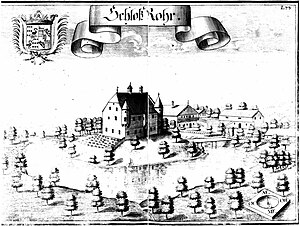Rohr Castle (Rottal)
| Rohr Castle | ||
|---|---|---|
|
Rohr Castle (Rottal) after a copper engraving by Michael Wening from 1721 |
||
| Castle type : | Location | |
| Conservation status: | Burgstall | |
| Standing position : | Noble | |
| Place: | Pocking - down tube | |
| Geographical location | 48 ° 22 ′ 59 ″ N , 13 ° 15 ′ 0 ″ E | |
|
|
||
The castle of the Rohrer is an Outbound castle in today's down tube in the town of Pocking in Lower Bavaria .
history
Rohr Castle in the Rottal was the ancestral seat of the Bavarian Rorer ( Rohrer ). A Rafolt de Rore is mentioned in a document as early as 1033. Around 1160, the diocese of Regensburg and the diocese of Bamberg are named as the landlord of Rohr . From this it can be deduced that the Rohrer Ministeriale were these dioceses. In 1134 an Eberhardus de Rore is mentioned here, who presumably did not live on the stone seat, but in a wooden defense structure.
The Rohrers also owned a Rohr castle of the same name, which no longer exists today , in the Kremstal valley. In the late Middle Ages, the stone residence was built on which the Rohrer are also suspected. The Rohrer had their burial place in the parish church of Rotthalmünster . Since 1304 the Rohrers have also acquired properties in the Mark Brandenburg.
The last of the Rohrers here is likely to have been Rapot der Rorar , attested to in 1466 , although it is questionable whether he was still based at Rohr Castle. In the country table of Duke George the Rich from the end of the 15th century, an Elsbet, a widow left behind by Alban Magens zu Rohr, is mentioned. The stomach were the last ones that still had their residence in Rohr. In 1558 Christoph von Schönburg was enfeoffed with cane. Rohr remained in the possession of this family until the death of Georg Adolph von Schönburg († 1716). Although the Oberste Lehenshof in Munich declared the Rohr fiefdom to have reverted to the Duke after his death , the Baroness Maria Jacob von Schönburg, who was married to Baron von Cloßen, was enfeoffed with Rohr on July 4, 1716. With this, Rohr came to the Closen , an important Bavarian noble family that also had possessions in Schönburg . Georg von Cloßen, who was raised to the rank of count, left two daughters, one of whom was married to Baron von Ingelheim and the other to Baron von Dachsberg. Rohr and the associated estates passed to these families. Since the Close no longer lived here, the building fell into disrepair.
Building history
On the copper engraving by Michael Wening from 1721, Rohr Castle is shown as a two-storey building with a half-hip roof , which is surrounded by a pond and thus protected. Access is via a wooden bridge, which is not further paved. The property has two small crowd watch towers and a pit bay . Next to the manor there is a farm outside the moat . In the topography of Apian pipe is called " praedium nobile called".
The noble seat was acquired by farmers in 1780 after the death of Count Closen and subsequently demolished. As is so often the case, the stones of the castle were reused as building material. Today you can no longer find any noticeable traces of terrain in the down tube that indicate the former manor house.
literature
- Passauer Neue Presse - Rottal regional edition: When there was still a real lock in the down tube. August 25, 2012.
- Renate Blickle: Griesbach Regional Court. (= Historical Atlas of Bavaria, part of Altbayern issue 19). Commission for Bavarian History, Michael Lassleben Verlag, Munich 1970.
Web links
Individual evidence
- ^ Homepage of the Rohr family
- ^ Franz von Krenner : Baierische Landtag actions in the years 1429 to 1513: Nieder- and Oberländische Landtag, in the united Landshut-Ingolstädter Landantheile, Volume 12 (Google eBook) Volume 12
- ^ Anton Eckardt: The art monuments of Bavaria. XXXI District Office Griesbach. R. Oldenbourg, Munich: 1929, p. 319.




